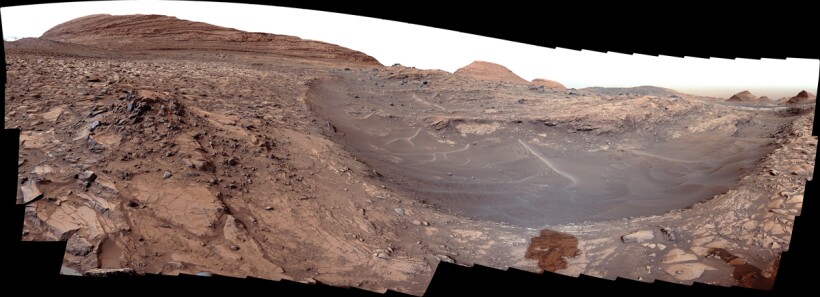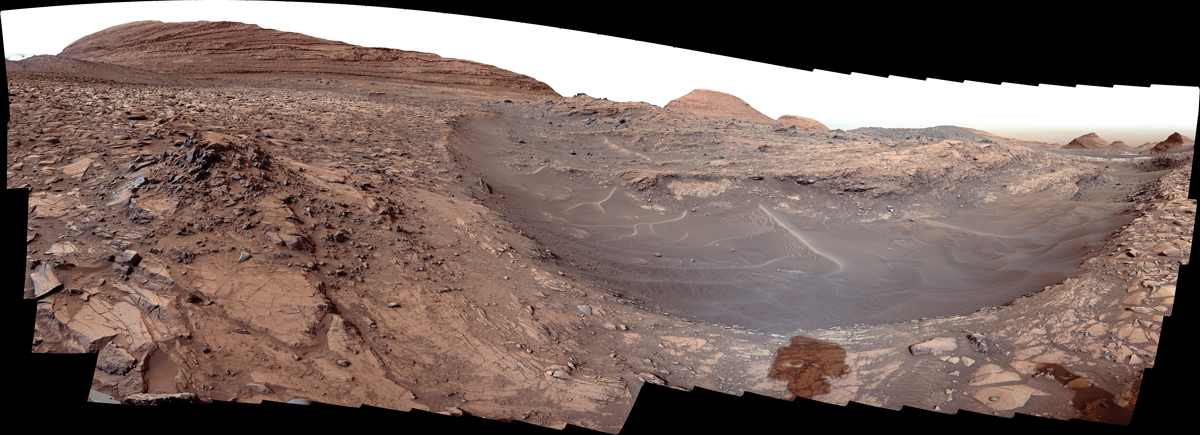The story of Mars’s early atmosphere is told in carbonate rocks
DOI: 10.1063/pt.upmn.jame

Piles of rocks, which could have formed from floods of water, are seen in this 180° panorama

Mars’s atmosphere, compared with Earth’s, is thin and wispy. Some of it was lost to space after the planet’s magnetosphere failed some 4 billion years ago (see the Quick Study by Bruce Jakosky, Physics Today, April 2022, page 62
For several decades, researchers studying Mars have used rovers and orbiters to search its sediments for evidence of CO2. The gas, after being emitted from volcanic eruptions, may have reacted with liquid water to form sedimentary carbonate rocks. Yet despite many remote-sensing observations, not enough carbonates have been found on the Martian surface to support an atmosphere rich with CO2. Now Benjamin Tutolo (University of Calgary) and colleagues have found a large carbonate reserve in the subsurface, in an iron-rich mineral not seen before on Mars. Called siderite, the mineral was found to have a nearly pure iron composition.
In 2022, NASA’s Curiosity rover reached Mount Sharp, a 5-kilometer-tall stack of sediments in Gale Crater, which is thought to have once been a lake. There, the rover drilled four samples. Tutolo and colleagues’ analysis identified not just siderite but also several other minerals, including sulfates and iron oxides. The finding of all the minerals together suggests that siderite, with its especially pure composition, precipitated out of an aqueous solution underground. Later, infiltrating fluids partially dissolved the siderite to form iron oxides. If the released carbon made its way to the atmosphere, it would have contributed to a Martian carbon cycle and potentially prolonged the duration of liquid water on the surface because of continued greenhouse warming.
Tutolo and colleagues speculate that the sulfate minerals masked the siderite from the reflectance and thermal emission spectroscopy approaches of remote-sensing instruments. Various sources would have added CO2 to Mars’s ancient atmosphere. Using a broad estimate for the amount of siderite that may be in the planet’s subsurface, the researchers predict that the carbonate-rich sediments contributed 2.6–36 millibars of CO2 to the total. The higher end of the range would offer enough atmospheric pressure to stabilize liquid water on the surface. But more CO2—potentially lost through other means such as atmospheric escape—would have been required to raise temperatures to habitable conditions.
The finding of siderite and its partial dissolution suggests a planetary carbon cycle. When atmospheric CO2 was plentiful, some was sequestered to form siderite, and then subsequent rock–water interactions released some CO2 back into the atmosphere. Now that the mineral has been found with sulfates, reanalysis of existing remote-sensing data could help determine whether large siderite deposits exist elsewhere. On the ground, other Mars rovers—Perseverance and Spirit, before it lost contact with Earth—spotted iron-rich oxides close to sulfates in various locations. The samples that Perseverance has collected, and that NASA hopes to bring back by 2040, will likely yield new clues about the planet’s ancient atmosphere. (B. M. Tutolo et al., Science 388, 292, 2025
This article was originally published online on 15 May 2025.
More about the Authors
Alex Lopatka. alopatka@aip.org

